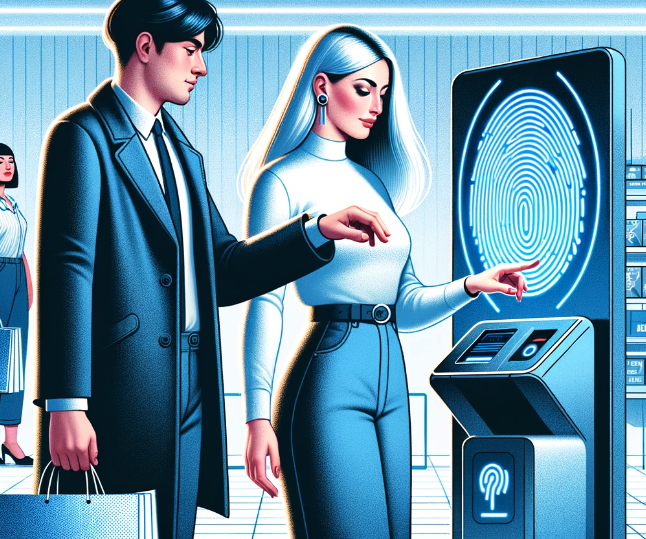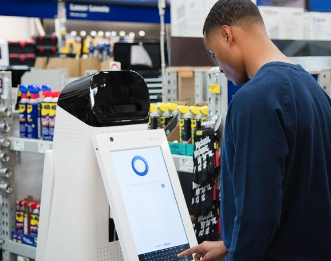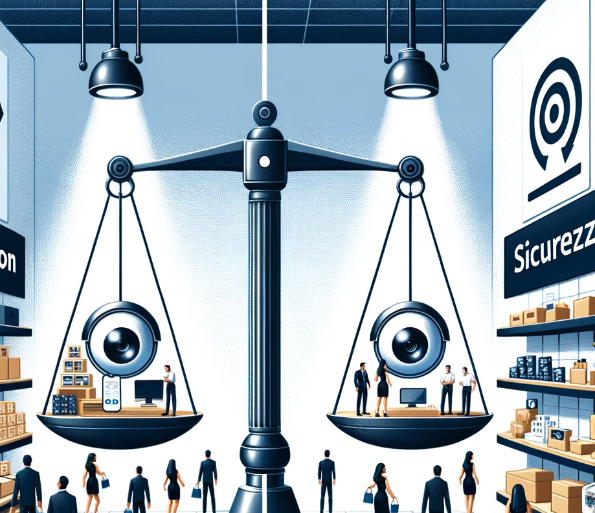AI in Retail: how Amazon is leading innovation
A few weeks after our first masterclass on "AI at the service of business" coordinated by Ye Seul Kim, Bullo and Lazzini, LFM University began releasing a series of update articles on the various applications of AI in various sectors, to help better understand the phenomenon and explore its various opportunities. Today we will discuss AI in the Retail world, a sector dear to LFM Spa, having worked over the years with prestigious brands that work in this world.
In recent times, the face of retail is undergoing a major transformation, led by giants like Amazon, which exploit advanced technologies to redefine the shopping experience. At the heart of this shift is the fusion of Artificial Intelligence (AI) and creativity, which not only streamlines transactions but also pushes the limits of what is possible in retail.
Today we will deal with this "business case" and will talk in particular about advanced applications of technology with particular reference to: Artificial vision, Generative AI, Machine learning, Biometrics, Optical engineering.
3 key aspects of digital revolution in Retail
In the modern retail landscape, the advent of Artificial Intelligence (AI) is ushering in a new era of convenience and innovation.
The three crucial aspects to keep in mind as we venture into this digital revolution are:
1.BIOMETRIC identity
2. The increase in COMFORT
3. AI that powers AI
Biometric identity in Retail for more intuitive experiences
In the retail space, biometric identity is emerging as a key solution to elevate the customer experience to new levels of convenience and personalization. Biometrics, which include palmprint, facial or fingerprint recognition, enable a series of frictionless interactions that eliminate many of the traditional complications associated with in-store shopping. There are platforms that allow customers to associate their payment information with a palm scan, allowing them to enter, shop and exit the store with unprecedented efficiency, all without having to take out their wallet or smartphone. This seamless transition significantly reduces wait times, especially during peak hours, improving customer satisfaction and driving brand loyalty. Additionally, biometric identification can give retailers a deeper understanding of customers' shopping habits, allowing for more effective personalization of offers and promotions. At the same time, biometric identity can also improve the security of transactions, reducing the risk of fraud and giving customers additional peace of mind while shopping.

More convenient
Innovation in the retail industry is reaching new heights, making the in-store shopping experience more seamless and frictionless. Now, you can walk into a store, select the items you want, and walk out without having to wait in line to checkout. This revolution is made possible thanks to a sophisticated network of cameras, sensors and algorithms that track the movements and interactions of visitors inside the store in real time, recording the selected items and monitoring the exit of customers. This technology not only eliminates the long waits typical of the traditional shopping experience, but also offers customers unprecedented freedom and autonomy, allowing them to manage their time as they wish. Additionally, accurately tracking item selections helps prevent potential losses and theft, while providing retailers with valuable data on customer behavior and purchasing preferences. This new shopping model is redesigning the retail landscape, making purchasing a more pleasant, efficient and customer-centric experience. This is an exciting step forward towards a more technologically integrated and consumer-focused retail future, where convenience and efficiency are at the heart of the shopping experience.
AI empowering AI
Artificial Intelligence (AI) is entering a revolutionary phase, where AI helps to further enhance AI: through the use of generative AI, it is now possible to create synthetic data that serves to train and refine more AI models robust, suitable for a multitude of use cases in the retail sector. This technological evolution not only opens new frontiers in predictive analytics and automation, but also in providing more seamless and personalized customer experiences. Generative AI, by creating rich and varied data scenarios, helps AI systems better understand and adapt to a wider range of customer situations and behaviors, thus improving the efficiency and effectiveness of interactions in the world of retail . For example, it could improve inventory management, offer personalization and customer service efficiency. This bringing together of technology and humanity in the retail sector suggests a future in which the shopping experience becomes more intuitive, responsive and centered on customers' individual needs and desires. The intertwining of generative AI with operational AI therefore represents a significant step forward towards a more advanced and personalized retail era, where technology serves to intensify the humanity of the shopping experience, rather than supplant it.
Why we need to look at Amazon
Amazon, a recognized giant in the world of e-commerce, also stands out as a driving force in the technological domain, with a commanding presence in the cloud computing sector. Its boldness in pioneering the intersection of technology and retail has not only established an industrial benchmark, but also opened the way to new horizons of innovation for other players in the sector. Amazon's efforts go far beyond simply selling online; the company has embraced a holistic vision that aims to reimagine the entire shopping experience, integrating advanced technological solutions to make shopping more intuitive, faster and convenient. Through groundbreaking initiatives like Amazon Go and Amazon One, it introduced the world to the concept of cashier-free stores and biometric identification-based transactions, respectively. These innovations represent not only a quantum leap in customer convenience, but also highlight Amazon's ability to lead the retail industry into a digital future. Its continued exploration of the potential of artificial intelligence and machine learning is also manifested in the way it has enhanced logistics, inventory management and customer engagement, thus establishing a robust model that many others are now seeking to emulate . In this evolving landscape, Amazon emerges not just as a seller, but as a technological innovator, charting the path to a more interconnected, consumer-centric retail future.
Amazon One & Just walk out: applied technology and AI
Amazon One epitomizes the essence of a contactless shopping experience by allowing customers to leave their wallets and phones at home, and instead, use their palm for transactions. Using infrared light, Amazon One scans your palm, creates a unique signature linked to a credit card or Amazon account, thus simplifying the purchasing process.
"Your palm is all you need" is how they present the service, making clear the great intuitiveness of the purchasing process.

Additionally, the "Just Walk Out" (JWO) technology of Amazon Go stores revolutionizes the conventional shopping experience. Here, customers can simply walk in, grab the items they need, and walk out without the hassle of queuing or checking out. This seamless experience is powered by a combination of cameras, sensors, algorithms and computer vision technology that meticulously monitors customers' activities within the store.
The power of generative AI further enhances these technologies. Amazon's research teams have leveraged generative AI to create synthetic data, which has significantly improved the robustness of "Just Walk Out" technology and Amazon One. By generating synthetic images and video clips, the system has been trained to handle complex use cases, thus amplifying its effectiveness.
But let's not underestimate
The idea of AI creating other AI raises concerns about stability. While Amazon's exercise shows potential, there have been some setbacks that should not be underestimated. The complexities in validating generative AI, especially with complex data types such as text and images, often pose challenges. Furthermore, the looming threats of heritability of bias and invasion of privacy are pertinent observations in this effort.
Altri esempi nel retail
The wave of Artificial Intelligence (AI)-driven innovation in the retail sector extends far beyond the confines of Amazon, showing how technology can be a catalyst for change on a larger scale. For example, Walmart, another retail giant, has embraced the AI revolution by introducing an innovative solution to keep shelves always stocked. This AI-based approach enables more precise and timely inventory management, ensuring that best-selling items are always available, thus improving customer satisfaction and optimizing warehouse operations.
In parallel, Lowes brought AI directly to its store aisles through the implementation of the LoweBot. This robotic assistant helps customers find what they are looking for in the store, providing detailed product information and guiding them through the shelves. The LoweBot represents an eloquent example of how AI can improve the customer experience, making shopping more efficient and less stressful.

These initiatives highlight the versatility and broad spectrum of applications of AI in the retail sector. Whether it's optimizing inventory management or providing customer support in an interactive and informative way, AI is emerging as a driving force for improvement and innovation. The retail landscape is evolving rapidly, with companies leveraging AI to create more intuitive, efficient and satisfying shopping experiences. These developments highlight the incredible potential of AI to shape the future of retail, promising an era of greater personalisation, efficiency and, above all, greater customer-centricity in every aspect of the shopping experience.
Let's pay attention!
Innovation in the retail sector, while bringing significant benefits in terms of efficiency and convenience, also raises important questions relating to security and crime prevention. The growing trend towards cashier-less stores, while revolutionary, puts the spotlight on the question of the viability of such models in a context of growing retail crime. The absence of human supervision could, theoretically, facilitate shoplifting and other criminal activity within stores. This scenario could pose a significant challenge for retailers, who must balance innovation with the need to maintain a safe and regulated retail environment.

On the other hand, technology itself could offer solutions. Advanced monitoring systems, incorporating high-resolution cameras, sophisticated sensors and recognition algorithms, could serve as an effective deterrent against criminal activity. These systems can identify and track suspicious movements in real time, providing a level of surveillance that, in some cases, could surpass human surveillance. Furthermore, the storage and analysis of the data collected could contribute to a better understanding and prevention of crime dynamics in shops.
The debate on these issues is complex and requires in-depth examination that takes into account the ethical, legal and social implications. Retail security of the future may require a holistic approach that integrates technological innovation with well-considered crime prevention strategies. We invite collective reflection on these crucial aspects and urge you to share your opinions and experiences in the comments below, thus contributing to a constructive dialogue that can guide the sector towards sustainable and responsible solutions.
Continue to follow us! We will continue to publish updates on these technologies and the use of AI.
Stay tuned!
